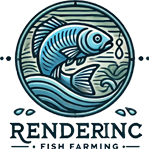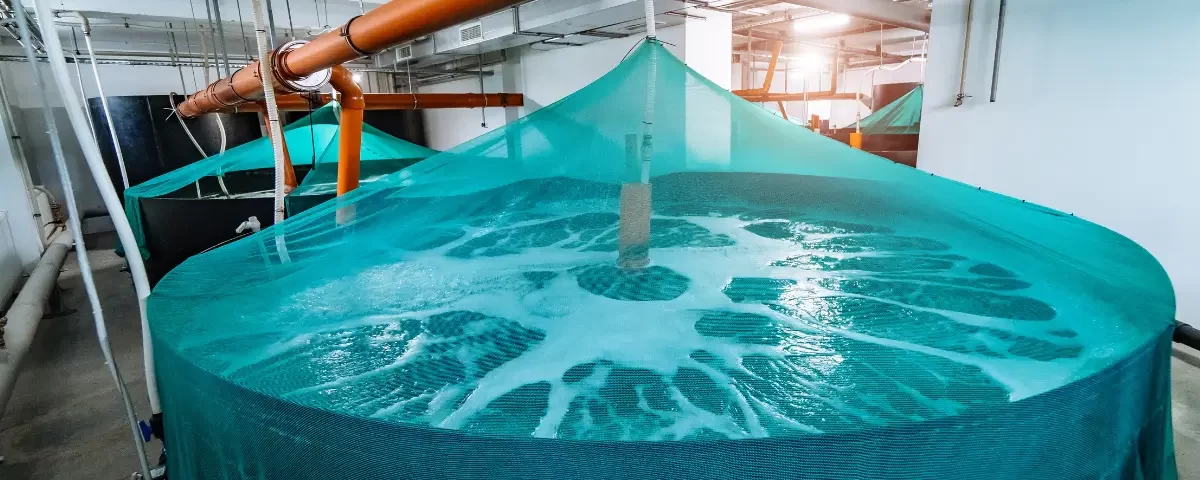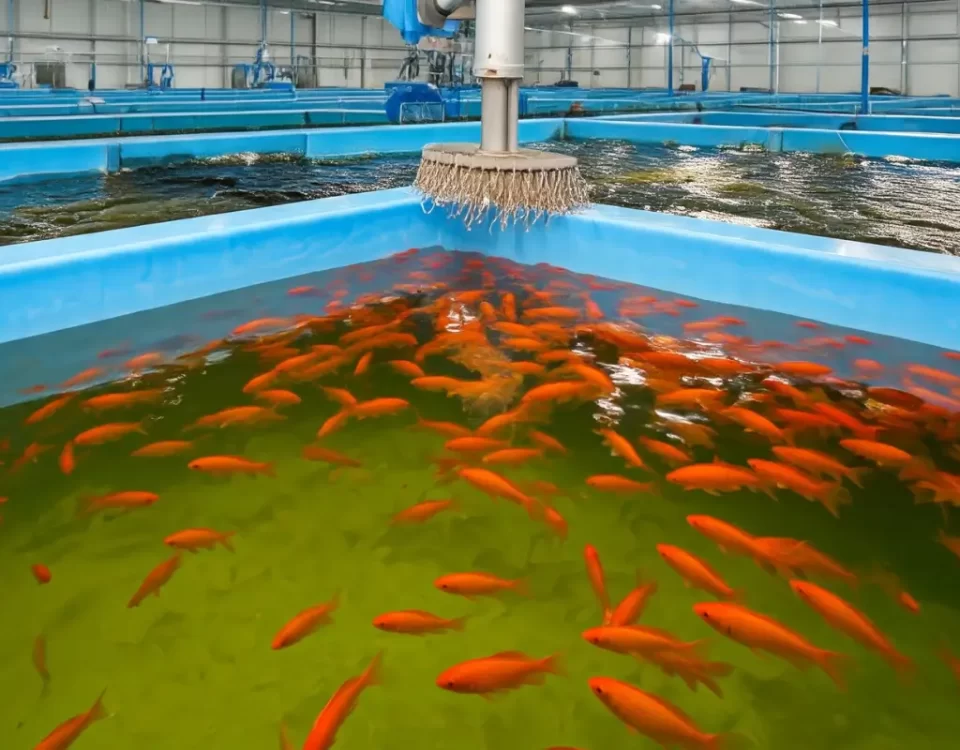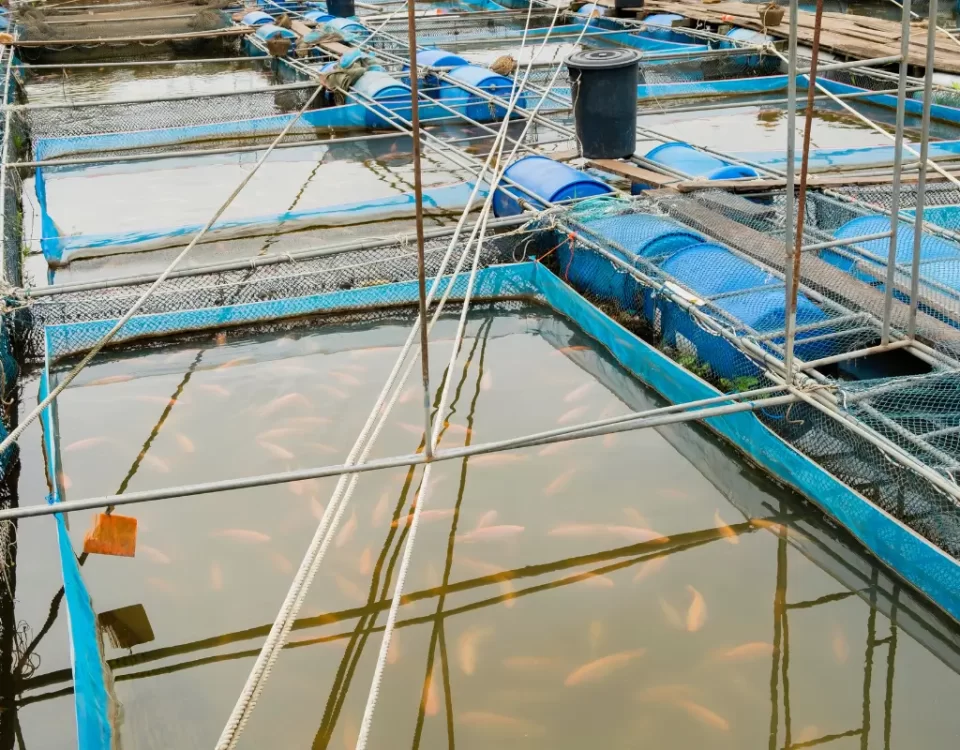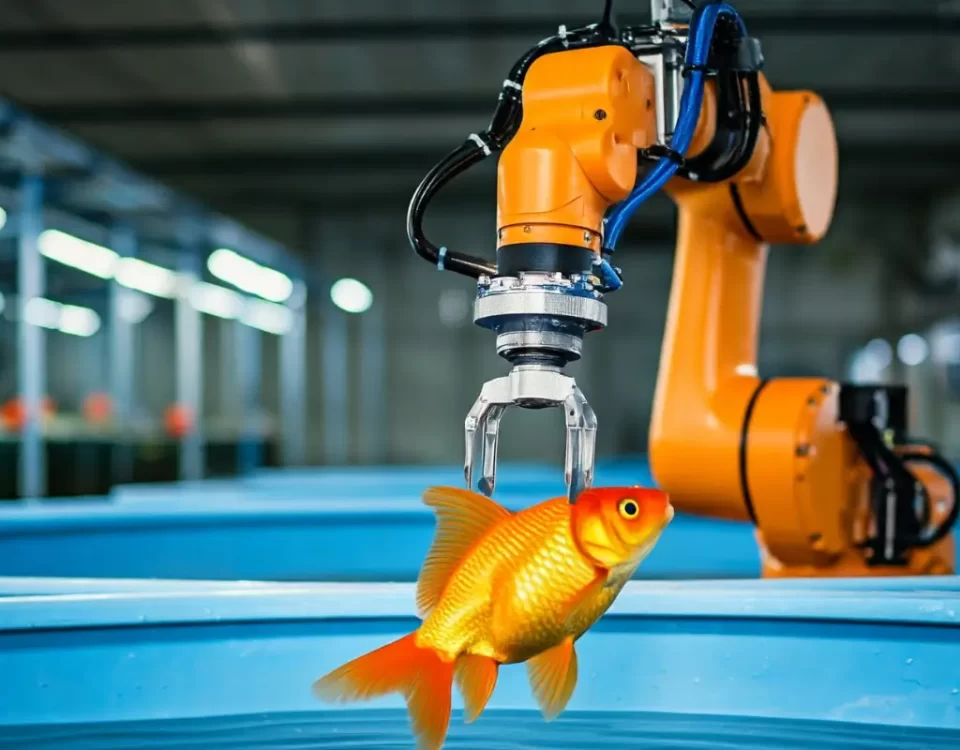Exploring the Benefits of Recirculating Aquaculture Systems (RAS)

The Role of Robotics in Automated Fish Farming: A Deep Dive
setembro 12, 2024
How to Use Waste from Fish Farms for Agriculture
setembro 13, 2024In the realm of modern aquaculture, one method gaining significant recognition for its efficiency and sustainability is Recirculating Aquaculture Systems (RAS). These systems represent a technological advancement in fish farming by reusing water within a closed-loop environment. By continuously filtering and treating the water, RAS allows for optimal control over water quality and environmental conditions to promote healthier fish.
With the global demand for seafood steadily increasing, the adoption of RAS in fish farming is on the rise. Fish farmers are turning towards this innovative approach as a solution to meet the growing need for sustainable aquatic food production. The appeal of RAS lies in its capability to maximize water usage efficiency, reduce the risk of disease outbreaks, and minimize environmental impacts associated with traditional open-water aquaculture practices.
Increasing Popularity of RAS in Fish Farming
Traditional open-water aquaculture poses challenges such as water pollution, habitat destruction, and disease transmission, prompting a shift towards more environmentally friendly practices like RAS. This shift is evident in the increasing number of aquaculture facilities adopting recirculating systems worldwide. Not only does RAS offer a solution to the limitations of traditional aquaculture, but it also presents opportunities for increased productivity and profitability in the industry.
Exploring the Benefits of RAS
Throughout this article, we will delve into the multifaceted benefits of Recirculating Aquaculture Systems. From improved water quality management to reduced environmental footprint, RAS holds the promise of revolutionizing the way we approach fish farming. By examining the advantages in detail, we aim to shed light on why RAS is gaining momentum as a preferred method for sustainable aquaculture practices.
Understanding Recirculating Aquaculture Systems (RAS)
Recirculating Aquaculture Systems (RAS) have emerged as a revolutionary method in fish farming, offering a sustainable and efficient approach to aquaculture. In essence, RAS is a closed-loop system that reuses water within tanks, minimizing the need for constant water exchange. By continuously filtering and treating the water, RAS creates a controlled environment conducive to optimal fish growth and health.
Definition of RAS
RAS is a sophisticated aquaculture technology that maximizes water efficiency by recycling and treating it within a closed system. This closed-loop approach distinguishes RAS from traditional aquaculture methods, where water is constantly replenished and discharged. Implementing RAS requires meticulous monitoring of water quality parameters such as oxygen levels, ammonia concentrations, and temperature to maintain a healthy aquatic environment for the fish.
Components of an RAS
Key components of a RAS include tanks for fish rearing, biological filters to remove waste, mechanical filters to capture solids, aeration systems to oxygenate the water, and pumps to circulate the water through the system. Each element plays a crucial role in maintaining water quality and creating a stable habitat for fish growth. Additionally, advanced RAS setups may incorporate technologies like UV sterilizers and ozone reactors to further enhance water treatment.
How RAS Functions Compared to Traditional Fish Farming Methods
Unlike conventional fish farming practices that rely on open systems where water flows in and out continuously, RAS operates in a closed-loop fashion, conserving water resources and minimizing environmental impact. By recirculating water through filtration processes and removing waste products, RAS reduces the risk of water pollution and disease outbreaks. This controlled environment also allows for higher stocking densities and improved biosecurity compared to traditional methods.
Environmental Sustainability of RAS
The environmental sustainability of RAS lies in its ability to minimize water usage and waste discharge, mitigating the ecological footprint of aquaculture operations. By significantly reducing water requirements and controlling effluent discharge, RAS offers a more environmentally friendly alternative to traditional fish farming. Additionally, the ability to optimize feed conversion ratios and reduce reliance on antibiotics contributes to the overall sustainability of RAS systems.
Benefits of Recirculating Aquaculture Systems (RAS)
Water Conservation
Recirculating Aquaculture Systems (RAS) stand out for their exceptional water conservation capabilities. Unlike traditional fish farming methods that continuously release water into the environment, RAS recycles and reuses water within a closed system. This closed-loop system significantly reduces water waste and consumption, making it a sustainable choice for aquaculture operations. In comparison, traditional fish farming methods can be water-intensive, leading to water scarcity and environmental concerns.
Comparison to Traditional Fish Farming Methods
When considering water usage, RAS systems outperform traditional fish farming practices by a significant margin. Traditional methods often require large volumes of water for fish rearing, leading to high water consumption and potential pollution of natural water bodies. RAS, on the other hand, recycles water through filtration and treatment processes, minimizing the need for fresh water inputs and reducing the environmental impact associated with water usage in aquaculture.
Importance of Water Conservation in Aquaculture
Water conservation is paramount in aquaculture to ensure sustainable practices and environmental stewardship. With global concerns about water scarcity on the rise, adopting water-efficient technologies like RAS becomes crucial for the long-term viability of the aquaculture industry. By conserving water resources through innovative systems like RAS, aquaculture operations can minimize their ecological footprint and contribute to the preservation of freshwater ecosystems for future generations.
Sustainable Water Management
Effective water management is a cornerstone of sustainable aquaculture, and RAS plays a key role in promoting responsible water usage. By optimizing water recycling and minimizing waste, RAS not only enhances operational efficiency but also reduces the strain on natural water resources. Implementing water conservation strategies through RAS not only benefits the environment but also ensures the continued growth and success of aquaculture enterprises in a water-conscious world.
Economic Viability of RAS
When considering the economic viability of adopting Recirculating Aquaculture Systems (RAS), it is essential to analyze both the initial investment costs and the long-term financial benefits. Setting up an RAS facility requires a significant initial investment, as the technology involved in recirculating water and maintaining optimal environmental conditions for fish is complex and requires specialized equipment. The costs of building the infrastructure, purchasing tanks, filtration systems, aeration devices, and monitoring equipment can be substantial. However, despite the high initial outlay, the operational costs of running an RAS facility can be more efficient and cost-effective in the long run.
Initial Investment and Operational Costs
The initial investment for setting up an RAS facility depends on various factors such as the scale of the operation, the type of species being farmed, and the level of automation desired. Small-scale RAS setups typically have lower upfront costs compared to larger commercial operations. Additionally, ongoing operational costs include expenses for electricity to power pumps and aerators, water treatment supplies, fish feed, maintenance, and labor. While these operational costs are continuous, they can be controlled and optimized through efficient management practices.
Long-Term Cost Savings and Potential Profits
One of the key advantages of RAS is its potential for significant long-term cost savings. By recirculating and treating water within the system, RAS minimizes water consumption and waste discharge, reducing the need for large volumes of freshwater and mitigating environmental impact. Additionally, RAS allows for year-round production, which can lead to more consistent harvests and higher profits. Over time, the initial investment in RAS technology can be offset by savings in water usage, feed efficiency, and reduced disease outbreaks, ultimately resulting in increased profitability for fish farmers.
Economic Benefits for Fish Farmers
Fish farmers who transition to RAS technologies can reap a multitude of economic benefits. Improved water quality and biosecurity in RAS facilities reduce the risk of disease outbreaks, minimizing losses from mortalities and treatment costs. The ability to control environmental parameters such as temperature, oxygen levels, and ammonia concentrations allows for optimized growth rates and feed conversion efficiency. Furthermore, the ability to farm fish in a land-based, controlled environment opens up opportunities for premium pricing in niche markets that value sustainability and high-quality products. Overall, the economic advantages of RAS make it an attractive option for fish farmers looking to enhance profitability and sustainability in their operations.
Case Studies and Success Stories
In the realm of fish farming, Recirculating Aquaculture Systems (RAS) have garnered attention for their potential to revolutionize the industry. Through real-world examples and success stories, the benefits of RAS become vividly apparent, showcasing how this innovative technology is reshaping the landscape of aquaculture practices globally.
Real-world Examples of Successful RAS Implementation
One striking example of successful RAS implementation comes from Norway, a country known for its progressive approach to aquaculture. In a salmon farming operation in the fjords of Norway, RAS technology has been seamlessly integrated to create a closed-loop system that significantly reduces environmental impact. By efficiently recirculating water and maintaining optimal conditions for salmon growth, this farm has not only increased production yields but has also minimized waste discharge into the pristine waters of the fjords.
Case Studies Highlighting the Benefits of RAS
Moving across the globe to Singapore, a densely populated city-state with limited land resources, RAS has emerged as a game-changer for tilapia farming. In a state-of-the-art RAS facility, tilapia farmers have been able to maximize production output in a controlled environment, free from the constraints of traditional pond farming. The result is a sustainable operation that ensures consistent quality, reduced water usage, and minimal environmental impact, setting a new standard for aquaculture practices in urban settings.
Success Stories of Fish Farmers Embracing RAS Technology
In the heart of the United States, a family-owned trout farm in the mountains of Appalachia has witnessed a remarkable transformation through the adoption of RAS technology. By transitioning from traditional flow-through systems to a recirculating setup, the farm has not only improved water quality and fish health but has also increased production efficiency. This success story underscores the versatility of RAS technology across different species, showcasing its potential to benefit small-scale operations seeking sustainable solutions.
Through these case studies and success stories, it becomes clear that Recirculating Aquaculture Systems (RAS) are not just a theoretical concept but a practical and proven method for enhancing fish farming practices. As more farmers around the world embrace RAS technology, the future of sustainable aquaculture looks brighter, promising increased yields, reduced environmental impact, and improved profitability.
Challenges and Considerations
Setting up a Recirculating Aquaculture System (RAS) can bring numerous benefits to fish farmers, but it is not without its challenges. Understanding and addressing these hurdles is essential to successful implementation.
Potential Challenges Faced when Implementing RAS
One significant challenge faced when implementing RAS is the initial high capital investment. The technology, equipment, and infrastructure required for a RAS setup can be costly, particularly for smaller fish farming operations. This financial barrier may deter some farmers from transitioning to RAS, despite the long-term advantages it offers.
Another challenge is the complexity of RAS systems. Maintaining water quality, managing biofilters, controlling oxygen levels, and monitoring parameters such as temperature and pH require specialized knowledge and expertise. Proper training and ongoing support are crucial to ensure the efficient operation of a RAS facility.
Solutions to Common Obstacles in Adopting RAS Technologies
To overcome the financial challenges associated with setting up a RAS system, fish farmers can explore funding opportunities, grants, or subsidies offered by government programs or private entities. Collaborating with financial institutions or entering into partnerships with investors may also help in raising the necessary funds.
Addressing the complexity of RAS systems requires investing in staff training and education. Fish farmers should consider hiring experienced RAS technicians or providing training for existing employees. Additionally, working closely with RAS technology suppliers or consultants can offer valuable insights and guidance in operating and maintaining the system effectively.
Key Considerations for Fish Farmers Looking to Transition to RAS
Before transitioning to RAS, fish farmers should conduct a comprehensive feasibility study to assess the suitability and profitability of implementing this technology. Factors such as the species of fish being cultivated, market demand, water availability, energy costs, and regulatory requirements should be carefully evaluated.
Moreover, fish farmers must have a clear understanding of the environmental impact of RAS systems. While RAS is known for its sustainability benefits, such as reduced water usage and waste discharge, proper waste management and energy efficiency practices must be implemented to minimize the ecological footprint of the facility. Working in alignment with environmental regulations is essential to ensure compliance and long-term viability.
Future of RAS in Aquaculture
Recirculating Aquaculture Systems (RAS) have been gaining significant momentum in the aquaculture industry, with a promising future ahead. The relentless pursuit of innovation and sustainable practices in aquaculture has led to emerging trends and advancements in RAS technology. One of the key trends is the development of more efficient and integrated RAS systems that optimize resource utilization and minimize environmental impact.
Emerging Trends and Advancements in RAS Technology
Recent advancements in RAS technology include the integration of automation and remote monitoring, which enhance operational efficiency and management of RAS facilities. Furthermore, the use of recirculating biofilters and water treatment technologies has improved water quality and biosecurity within RAS systems. These innovations not only promote the well-being of aquatic species but also contribute to the economic viability of RAS operations.
Predictions for the Future Growth and Adoption of RAS in the Aquaculture Industry
The future of RAS in aquaculture is poised for substantial growth and widespread adoption. As consumer demand for sustainable and ethically sourced seafood continues to rise, RAS presents a viable solution to meet these market demands. Industry experts predict that RAS will play a crucial role in enhancing production efficiency and meeting the growing global seafood demand in a responsible manner.
Role of RAS in Sustainable Food Production and Global Food Security
RAS holds immense potential in promoting sustainable food production and enhancing global food security. By reducing reliance on wild-caught fish stocks and mitigating the environmental impact of traditional aquaculture practices, RAS contributes to a more resilient and sustainable food system. Additionally, the controlled environment of RAS facilities minimizes the risk of disease outbreaks and pollution, ensuring a consistent and reliable supply of high-quality seafood to consumers worldwide.
In conclusion, the future of RAS in aquaculture looks promising, driven by continuous innovation, efficiency, and a commitment to sustainability. As the aquaculture industry evolves, RAS is set to play a pivotal role in reshaping the way seafood is produced, contributing to a more sustainable and secure global food supply.
Reaping the Rewards of RAS
In delving deep into the realm of recirculating aquaculture systems (RAS), we have uncovered a multitude of benefits that this innovative technology offers to fish farmers. From reduced water usage and land requirement to enhanced biosecurity and waste management, RAS shines as a beacon of sustainability and efficiency in the realm of aquaculture. The ability to closely monitor water quality parameters and optimize conditions for fish growth sets RAS apart as a game-changer in the industry, promising higher yields and healthier fish.
Embracing the Future with RAS
For fish farmers seeking to elevate their operations and embrace a more sustainable approach to fish production, considering the adoption of RAS is a compelling choice. The potential economic savings, environmental impact reduction, and increased production capacity make RAS a smart investment for those looking to future-proof their aquaculture ventures. By transitioning to RAS, fish farmers not only stand to benefit from improved productivity and profitability but also contribute to the preservation of precious natural resources.
Pioneering Innovation for a Brighter Tomorrow
As we reflect on the transformative power of recirculating aquaculture systems (RAS), it becomes evident that embracing innovative technologies is paramount for shaping a better future for aquaculture. By harnessing the capabilities of RAS and other cutting-edge solutions, fish farmers can revolutionize their practices, mitigate environmental impacts, and meet the growing demands of a burgeoning population. The time is ripe to champion sustainability, efficiency, and innovation in aquaculture, paving the way for a thriving industry that harmonizes with nature.
In closing, let us heed the call to action and encourage fish farmers far and wide to explore the boundless possibilities that RAS presents. By embracing this transformative technology, we not only unlock a myriad of benefits for our operations but also contribute to a more sustainable and prosperous future for aquaculture. Let us dare to dream, innovate, and lead the way towards a brighter tomorrow, where the waters teem with abundance, the land flourishes with promise, and our legacy as stewards of the sea endures for generations to come.

Michael Rivers is an experienced aquaculture enthusiast with over a decade of hands-on knowledge in fish farming and sustainable aquatic systems. Passionate about promoting eco-friendly practices, he shares his expertise on fish breeding, water management, and the latest advancements in aquaculture technology. Through his blog, Michael aims to help both beginners and seasoned fish farmers achieve success in their ventures while contributing to the growth of sustainable food production.
